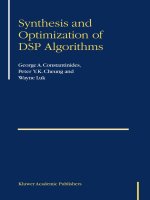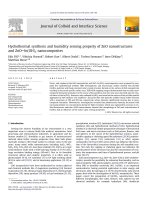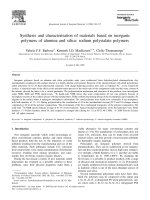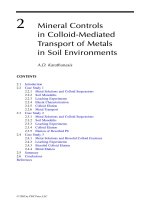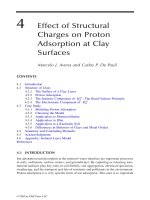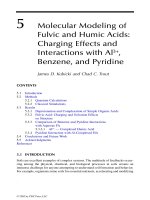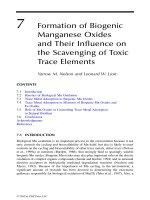Synthesis and reactivity of group 6 and group 8 organometallic complexes with sulfur containing ligands
Bạn đang xem bản rút gọn của tài liệu. Xem và tải ngay bản đầy đủ của tài liệu tại đây (3.46 MB, 195 trang )
SYNTHESIS AND REACTIVITY OF GROUP 6 AND GROUP 8
ORGANOMETALLIC COMPLEXES WITH SULFUR-
CONTAINING LIGANDS
KUAN SEAH LING
NATIONAL UNIVERSITY OF SINGAPORE
2008
SYNTHESIS AND REACTIVITY OF GROUP 6 AND GROUP 8
ORGANOMETALLIC COMPLEXES WITH SULFUR-
CONTAINING LIGANDS
KUAN SEAH LING
(B.Sc.(Hons.), NUS)
A THESIS SUBMITTED FOR THE DEGREE OF
DOCTOR OF PHILOSIPHY
DEPARTMENT OF CHEMISTRY
NATIONAL UNIVERSITY OF SINGAPORE
2008
Acknowledgements
Acknowledgements
The decision to take my PhD and completing it will not be possible by my own efforts
alone and I would like to take this opportunity to express my heartfelt gratitude to the
following people:
My supervisors, A/P Leong Weng Kee and Dr Goh Lai Yoong: For their guidance,
inspiration, support and all that they taught me in science and in life.
Mrs Hoo Boon Leng: For inspiring me to choose study Chemistry.
Dr Richard Webster from NTU: For the electrochemical studies and his invaluable
assistance in the discussion of the electrochemical studies; Dr Fan: For the invaluable
suggestions; Prof Peter McGill from ANU: For the computational studies; Dr Koh,
Ms Tan, Yanhui, Peggy, Mdm Wong, Hui Ngee and Zing: For their technical
expertise.
Sin Yee, Victor, Marlin, Huishan, Xiaofeng, and Jialin: It is my good fortune and
greatest pleasure to have worked with and become good friends with them. They have
been role models whom I learnt from and have contributed greatly to my growth in
the past few years. Their friendship, constant aid and discussion have made the road
to PhD smoother and more enjoyable.
Zhiqiang, Richard Shin, Alaric, Biqi, Chunxiang, Garvin, Kong, Chang Hong, Sridevi,
Pearly, Zhijie, Xueping and Kaining: For the helpful discussions and friendship.
My mum: For her unconditional support and encouragement all this while, without
which I would not have come this far.
Other members of my family and friends, including Xueli, Weihong, Jo, Kayla,
Wenxin, Huaying, Elaine Chan, Guihua, Elaine Tay TT and Han Yuan: For their
constant support and encouragement.
NUSNNI: For my research scholarship.
Table of Contents
Synthesis and Reactivity of Group 6 and Group 8 Organometallic Complexes with Sulfur-
containing Ligands I
Table of Contents
Summary V
Chart A: Compounds encountered in this thesis VIII
List of Tables X
List of Figures XI
List of Abbreviations XIV
Chapter 1. Transition Metal Complexes with Sulfur-containing Ligands 1
1.1. Scorpionate Complexes 2
1.1.1. Poly(methimazolyl)borates 4
1.1.2. Electrochemistry of scorpionate complexes 12
1.2.Heterocyclic Thiolate Complexes 14
1.2.1. Complexes of 2-mercaptobenzothiazole 16
1.2.2. Complexes of 2-mercaptopyridine 17
1.2.3. Complexes of 2-mercaptobenzoic acid 18
1.2.4. Complexes of 6-mercaptonicotinic acid 19
References 21
Chapter 2. Syntheses of mixed-sandwich Cp*Cr complexes containing
poly(methimazolyl)borates (Cp* = C
5
Me
5
) 28
2.1. Reaction of [Cp*CrBr
2
]
2
(1) with poly(methimazolyl)borate salts 30
2.2. Crystallographic studies 32
Table of Contents
Synthesis and Reactivity of Group 6 and Group 8 Organometallic Complexes with Sulfur-
containing Ligands II
2.3. Electrochemistry 35
2.4. Conclusion 39
2.5. Experimental 40
References 48
Chapter 3. Syntheses of mixed-sandwich (HMB)Ru complexes containing
poly(methimazolyl)borates (HMB=C
6
Me
6
) 49
3.1. Reaction of [(HMB)RuCl
2
]
2
(8) with poly(methimazolyl)borate salts 51
3.2. Crystallographic studies 54
3.3. Electrochemistry 56
3.4. Conclusion 58
3.5. Experimental 59
References 63
Chapter 4. Syntheses of mixed-sandwich Cp*Ru complexes containing
poly(methimazolyl)borates (Cp* = C
5
Me
5
) 64
4.1. Syntheses of [Cp*Ru] complexes containing poly(methimazolyl)borate
ligands 67
4.2. Cyclic Voltammetry 74
4.3. Isomerisation 79
4.4. Reactivity studies of Cp*Ru[HB(mt)
2
(pz)] (18) towards O
2
and CO 86
4.5. Conclusion 91
4.6. Experimental 93
Table of Contents
Synthesis and Reactivity of Group 6 and Group 8 Organometallic Complexes with Sulfur-
containing Ligands III
References 104
Chapter 5. One-Electron Electrochemical Oxidation of Half Sandwich
Ruthenium
Complexes, [Cp*Ru
IV
Cl
2
(S
2
CR)] (Cp* = C
5
Me
5
, R = NMe
2
, NEt
2
,
O
i
Pr) 106
5.1. Electrochemical oxidation and spectroscopic studies of
[Cp*Ru
IV/V
Cl
2
(S
2
CR)] complexes 108
5.2. Chemical oxidation of [Cp*Ru
IV
Cl
2
(S
2
CNMe
2
)] 116
5.3. Conclusion 120
5.4. Experimental 121
References 125
Chapter 6. Reactivity of [Cp’Ru(CO)
2
]
2
(Cp’ = C
5
H
5
or C
5
Me
5
) towards disulfide
ligands 128
6.1. Reaction of [Cp’Ru(CO)
2
]
2
(Cp’ = C
5
H
5
or C
5
Me
5
) with heterocyclic
disulfides 133
6.1.1. Electrochemical studies 138
6.1.2. Screening against cell lines 140
6.2. S-S bond cleavage reaction of [Cp’Ru(CO)
2
]
2
(Cp’ = C
5
H
5
or C
5
Me
5
)
with lysozyme 142
6.3. Conclusion 146
6.4. Experimental 147
References 154
Table of Contents
Synthesis and Reactivity of Group 6 and Group 8 Organometallic Complexes with Sulfur-
containing Ligands IV
Concluding Remarks 156
Publications and manuscripts in preparation 158
Appendices 159
Summary
Synthesis and Reactivity of Group 6 and Group 8 Organometallic Complexes with Sulfur-
containing Ligands V
Summary
This thesis deals with the synthesis and reactivity of some Group 6 and 8
organometallic complexes with sulfur-containing compounds, namely the
poly(methimazolyl)borate scorpionate ligands and the heterocyclic disulfides. After
an introduction given in Chapter 1, the results of the investigation are described in
five chapters.
Chapter 2 describes the reactions of [Cp*CrBr
2
]
2
(1) with (i) K[HB(mt)
3
], (ii)
Na[H
2
B(mt)
2
] and (iii) Li[HB(mt)
2
(pz)]. The 15-electron Cr(III) complexes,
[Cp*Cr(
3
-S,S’,S”)-{HB(mt)
3
}]Br (2), [Cp*Cr(
2
-S,S’)-{H
2
B(mt)
2
}Br] (3) and
[Cp*Cr(
2
-S,S’)-{HB(mt)
2
(pz)}Br] (4) were obtained in moderate to high yield.
Tridentate coordination of the [H
2
B(mt)
2
]
-
and [HB(mt)
2
(pz)]
-
can be effected by
reacting 3 and 4 with a silver salt to give [Cp*Cr(
2
-S,S’)-{H
2
B(mt)
2
}(NCMe)]PF
6
(5)
and [Cp*Cr(
3
-H, S,S’)-{{H
2
B(mt)
2
}]PF
6
(6), in the absence of acetonitrile. Likewise,
the reaction of 4 with AgPF
6
afforded [Cp*Cr(
3
-N,S,S’)-{HB(mt)
2
(pz)}Br] PF
6
(7).
The electrochemical behaviour of these complexes had also been studied.
The reactions of the 18-electron species, [(HMB)Ru
II
Cl
2
]
2
with the same
scorpionate salts are described in Chapter 3. Monocationic (HMB)Ru(II) complexes,
[(HMB)Ru
II
(
3
-S,S',S'')-{HB(mt)
3
}]Cl (9), [(HMB)Ru
II
(
2
-H,S,S')-{H
2
B(mt)
2
}]Cl (10)
and [(HMB)Ru
II
(
2
-H,S,S')-{HB(mt)
2
(pz}]PF
6
(11B) were obtained from these
reactions. An isomerisation process was observed for complex 11B in solution and
this process was investigated using
1
H NMR. The electrochemical behaviour of
complexes 9 and 10 were also investigated.
Chapter 4 describes the syntheses of mixed-sandwich Cp*Ru
II/III
complexes
with poly(methimazolyl)borates. [Cp*Ru
III
(
3
-S,S',S'')-{HB(mt)
3
}](14A)X (X = Cl,
Summary
Synthesis and Reactivity of Group 6 and Group 8 Organometallic Complexes with Sulfur-
containing Ligands VI
PF
6
) and [Cp*Ru
II
(
3
-S,S',S'')-{HB(mt)
3
}] (16A) were synthesized by the reactions of
K[HB(mt)
3
] with the 17-electrons precursor, [Cp*Ru
III
Cl
2
]
2
(12),
and the 16-electron
precursor, [Cp*Ru
II
(OMe)]
2
(13), respectively. [Cp*Ru
II
(
3
-H,S,S')-{H
2
B(mt)
2
}] (17)
and [Cp*Ru
II
(
2
-H,S,S')-{HB(mt)
2
(pz}] (18) were similarly synthesized from the
reaction of 13 with Na[H
2
B(mt)
2
] and Li[HB(mt)
2
(pz)]. The electrochemistry of
complexes 14A, 16-18 was investigated. Both 14A and 16A were found to undergo an
isomerization reaction in solution where the sulfur on one mt group is displaced in
favor of coordination to the hydrogen bonded to the boron (an agostic B–H–Ru
interaction) resulting in
3
-H,S,S' coordination about the Ru centre. The rate and
equilibrium constants associated with the isomerisation process have been determined
by theoretical digital simulation comparisons of experimental
1
H NMR spectroscopic
and cyclic voltammetric data over a range of temperatures. Oxidation of
Cp*Ru{HB(mt)
2
(pz)} (18) with O
2
and reaction with CO gave the peroxo- and CO-
adducts, Cp*Ru(
2
-S,S’)-{HB(mt)
2
(pz)}(O
2
) (19) and Cp*Ru(
2
-S,S’)-
{HB(mt)
2
(pz)}(CO) 20. The convertibility of 18, 19 and 20 were investigated and it
was found that the reactivity of 18 towards O
2
and CO is similar to that of
haemoglobin.
Chapter 5 describes the one-electron electrochemical oxidation of
[Cp*Ru
IV
Cl
2
(S
2
CR)] (21-22) to give the first examples of organometallic complexes
of Ru(V). However, an attempt to synthesise the Ru(V) species via chemical
oxidation of [Cp*Ru
IV
Cl
2
(S
2
CNMe
2
)] (21a) resulted in the isolation of two Cp*Ru
IV
species, 23 and 24 as a result of oxidation of the chloride co-ligands in 21a.
The reactions of [Cp’Ru(CO)
2
] (Cp’=C
5
H
5
, 25a; Cp’=C
5
Me
5
, 25b) with
heterocyclic disulfides give complexes of the type [Cp’Ru(CO)
2
(
1
-SR)] (26-29) are
described in Chapter 6. The antiproliferative activity of these complexes against
Summary
Synthesis and Reactivity of Group 6 and Group 8 Organometallic Complexes with Sulfur-
containing Ligands VII
MDA-MB231 and MCF-7 breast cancer cell lines were investigated. In addition, the
reactivity of 25 towards hen’s egg white lysozyme (HEWL) was investigated.
Chart A: Compounds encountered in this thesis
Synthesis and Reactivity of Group 6 and Group 8 Organometallic Complexes with Sulfur-
containing Ligands VIII
Chart A: Compounds encountered in this thesis
Cr
III
S
S
S
N
N
N
B
H
2
Br
Cr
III
Br
Cr
III
Br
Br
Br
1
Cr
III
S
S
N
N
B
H
Br
3
H
Cr
S
NCMe
S
N
N
B
H
H
PF
6
5
Cr
S
H
S
N
N
B
H
PF
6
6
Cr
S
Br
S
N N
B
N
H
4
N
Cr
S
N
S
N N
B
H
N
7
PF
6
K[HB(mt)
3
]
N
N
B
N
N
H
N
N
S
S
S
Na[H
2
B(mt)
2
]
N
N
B
N
H
H
N
S
S
Li[HB(mt)
2
(pz)]
N
N
B
N
N
H
N
S
S
N
K
+
Na
+
Li
+
Ru
II
Cl
Ru
II
Cl
Cl
Cl
8
Ru
II
S
S
S
N
N
N
B
H
Cl
9
Ru
II
S
H
S
N
N
B
H
Cl
10
Ru
II
S
N
S
N
N
B
H
PF
6
N
Ru
II
S
H
S
N
N
B
N
PF
6
11A 11B
Ru
III
Cl
Ru
III
Cl
Cl
Cl
12
Ru
II
Me
O
Ru
II
O
Me
13
Chart A: Compounds encountered in this thesis
Synthesis and Reactivity of Group 6 and Group 8 Organometallic Complexes with Sulfur-
containing Ligands IX
Chart A (continued)
List of Tables
Synthesis and Reactivity of Group 6 and Group 8 Organometallic Complexes with Sulfur-
containing LigandsX
List of Tables
Table 2.1. Selected bond parameters of complexes 2-7 34
Table 3.1. Equilibrium constants in d
3
-acetonitrile for Equilibrium I 54
Table 3.2. Bond parameters for complexes 9 and 10 55
Table 4.1. Variation of 16A: 16B with solvent composition. 70
Table 4.2. Selected bond lengths (Å) and bond angles (
o
) for 14A, 16-18. 73
Table 4.3. Oxidation potential of complexes 16-18 in CH
2
Cl
2
vs. Fc/Fc
+
.
75
Table 4.4. Kinetic data and equilibrium constants in d
8
-toluene for Equilibrium II.
82
Table 4.5. Thermodynamic parameters obtained from Eyring plots for
Equilibrium II 82
Table 4.6. Equilibrium, rate constants and electrochemical parameters obtained in
CH
2
Cl
2
(with 0.5 M Bu
4
NPF
6
) 84
Table 4.7. Selected bond lengths (Å) and bond angles (
o
) for 19 and 20 89
Table 5.1. Selected calculated
atomic charges, spin densities, and spin densities at
the nuclei in the neutral and oxidized forms of [Cp*RuCl
2
(S
2
CNMe
2
)]
(21a) 115
Table 5.2. Selected bond parameters of 23 and 24 119
Table 6.1. ν
C≡O
for complexes 26 and 27 135
Table 6.2. Selected bond lengths (Å) and bond angles (
o
) for 26-29 137
List of Figures
Synthesis and Reactivity of Group 6 and Group 8 Organometallic Complexes with Sulfur-
containing LigandsXI
List of Figures
Figure 2.1. X-band EPR spectrum of 3 in CH
3
CN recorded at 10 K 31
Figure 2.2. ORTEP plots for the molecular structures of 2-7 33
Figure 2.3. Cyclic voltammograms of 1.0 mM solutions of 2, 4 and 7 37
Figure 2.4. Cyclic voltammograms of 1.0 mM solutions of 3, 5 and 6 38
Figure 3.1. VT
1
H NMR of 11 from 300-345K 54
Figure 3.2. ORTEP plots of 9, 10, 11B and 11’ 55
Figure 3.3. Cyclic voltammograms performed at a 1 mm diameter planar GC
electrode in CH
2
Cl
2
(0.25 M Bu
4
NPF
6
) at233K or 293K and a scan rate
of 100 mV s
-1
for 0.5 mM of 8 and 9 57
Figure 4.1. Continuous wave X-band EPR spectra for 14A 68
Figure 4.2. 2D
1
H NMR EXSY spectrum for complex 16A/16B in C
6
D
6
71
Figure 4.3. ORTEP plots for the molecular structures of 14A, 16A, 17 and 18 72
Figure 4.4. Cyclic voltammograms recorded at a scan rate of 100 mV s
-1
at a 1 mm
GC electrode (a) 2.36 mM 14A.Cl in CH
2
Cl
2
with 0.5 M n-Bu
4
NPF
6
;
2.61 mM 16A/16B in CH
2
Cl
2
with 0.5 M n-Bu
4
NPF
6
(b) 0.5 mM 17 in
CH
2
Cl
2
with 0.25 M n-Bu
4
NPF
6
;1.0 mM 18 in CH
2
Cl
2
with 0.2 M n-
Bu
4
NPF
6
74
Figure 4.5. Continuous wave X-band EPR spectra for 14B 78
List of Figures
Synthesis and Reactivity of Group 6 and Group 8 Organometallic Complexes with Sulfur-
containing LigandsXII
Figure 4.6. VT 300 MHz
1
H NMR spectra of 16A/16B in d
8
-toluene 80
Figure 4.7. Experimental (solid line) and simulated (dashed line) VT 300 MHz
1
H
NMR spectra of 16A/16B in d
8
-toluene 81
Figure 4.8. ORTEP plots for the molecular structures of 19 and 20 89
Figure 4.9. Cyclic voltammograms recorded at a scan rate of 100 mV s
-1
at a 1 mm
planar GC electrode in CH
2
Cl
2
solutions containing 0.2 M Bu
4
NPF
6
and 1 mM 19 and 20 90
Figure 5.1. Cyclic voltammograms recorded in CH
2
Cl
2
with 0.5 M Bu
4
NPF
6
at a
Pt electrode of 1.0 mM solutions of 21 and 22 109
Figure 5.2. First derivative continuous wave X-band EPR spectra recorded in
CH
2
Cl
2
with 0.5 M Bu
4
NPF
6
of (a) 21a
+
at 293 K. (b) 21a between
273 - 6 K. (c) 22b
+
and 22
+
at 233 K. 111
Figure 5.3. UV-vis-NIR spectra obtained during the one-electron in situ
electrochemical oxidation of 1.0 mM 21a in CH
2
Cl
2
with 0.5 M
Bu
4
NPF
6
in an OTTLE cell 113
Figure 5.4. ORTEP plot for the molecular structure of (a) 21a (b) 23 and (c) 24
119
Figure 6.1. (a) ORTEP plot of 26b and (b) General numbering scheme for
Cp’Ru(CO)
2
(SR) complexes 137
Figure 6.2. Cyclic voltammograms of 1.0 mM of (a) 26a. (b) 26b. (c) 27b and (d)
26c recorded at a scan rate of 100 mV s
-1
in CH
2
Cl
2
solutions
List of Figures
Synthesis and Reactivity of Group 6 and Group 8 Organometallic Complexes with Sulfur-
containing LigandsXIII
containing 0.25 M Bu
4
NPF
6
at a 1 mm diameter planar Pt electrode
138
Figure 6.3. MTT assay for (a) 26-27 against MDA-MB231 and (b) 26-27 against
MCF10A. 141
Figure 6.4. UV/Vis spectra of (a)HEWL (5 µM, -) and [CpRu(CO)
2
]
4
-HEWL (5
µM, -) in water 144
Figure 6.5. IR spectrum of 32 145
Figure 6.6. MALDI-ToF spectrum of (a) complex 32 and (b) HEWL 145
List of Abbreviations
Synthesis and Reactivity of Group 6 and Group 8 Organometallic Complexes with Sulfur-containing Ligands XIV
ΔG
θ
ΔG
≠
ΔH
θ
ΔH
≠
ΔS
θ
ΔS
≠
br
ca
calc.
COSY
Cp
Cp*
CPE
CV
d
dd
δ
e
E1/2
Et
EPR
equiv.
et al.
ESI
FAB-MS
FTIR or IR
GC
h
HMB
i.e.
Gibbs free energy
activation energy
enthalpy
activation enthalpy
entropy
activation entropy
Broad
about (Latin circa)
calculated
Correlation Spectroscopy
η5-cyclopentadienyl
η5-pentamethylcyclopentadienyl
constant phase elements
Cyclic voltammetry or Cyclic voltammogram
doublet (NMR)
doublet of doublet (NMR)
NMR chemical shift in ppm
Electron
electrode potential
ethyl
Electron Paramagnetic Resonance
equivalent(s)
and other (Latin et alii)
Electrospray Ionisation
Fast Atom Bombardment Mass Spectrometry
Fourier Transform Infra Red
Glassy carbon
Hour
η6-hexamethylbenzene
this is (Latin id est)
Ind
J
iPr
KBr
K
eq
k
f
k
b
m
M+
MALDI-ToF
Me
MeCN
MeOH
min
m/z
NMR
NOESY
q
RT
s
sh
t
t
T
THF
upe
UV-VIS
VT
vs
vw
w
Indenyl
coupling constant
isopropyl
potassium bromide
equilibrium constant
rate for forward reaction
rate for backward reaction
multiplet (NMR) / medium intensity (IR)
parent ion peak (mass spectrometry)
Matrix Assisted Laser Desorption-Time of Flight
methyl
acetonitrile
methanol
minute
mass to charge ratio
nuclear magnetic resonance
Nuclear Overhauser Enhancement Spectroscopy
quartet (NMR)
room temperature
singlet (NMR) / strong intensity (IR)
shoulder (IR)
triplet (NMR)
tertiary
temperature
tetrahydrofuran
unnatural parity exchange
Ultraviolet-Visible
variable temperature
very strong intensity (IR)
very weak intensity (IR)
weak intensity (IR)
Chapter 1
Synthesis and Reactivity of Group 6 and Group 8 Organometallic Complexes with Sulfur-
containing Ligands 1
Chapter 1. Transition Metal Complexes with Sulfur-containing Ligands
There are numerous reports of half-sandwich complexes of transition metals
in the literature as they are good precursors for entry into a variety of organotransition
metal complexes.
1-16
In particular, our group has been interested in the synthesis and
reactivity of half-sandwich complexes of chromium and ruthenium,
17-23
for instance,
the synthesis and reactivity of half sandwich complexes with thiolate ligands (Chart
1.1), giving complexes exhibiting unusual reactivity and coordination modes.
22, 24, 25
More recently, the synthesis and reactivity of a series of half-sandwich chromium and
ruthenium complexes with sulfur-containing tripodal ligands was reported by our
group and it was found that they can act as metalloligands to give rise to a wide
variety of heterobimetallic complexes.
26-28
Chart 1.1. Half sandwich chromium and ruthenium complexes with S-containing
ligands.
Transition metal sulfur complexes and their chemistry are extensively
exploited in both industry and biology.
29
In industry, metal sulfides play important
roles in catalysis, lubrication and antioxidation processes. Many of the biologically
essential transition metals made use of sulfur coordination in one way or another in
their biological manifestations. Due to the importance of transition metal sulfur
complexes, there is continuing research in the synthesis, reactivity and applications of
Chapter 1
Synthesis and Reactivity of Group 6 and Group 8 Organometallic Complexes with Sulfur-
containing Ligands 2
new transition metal sulfur complexes. One such class of complexes is the half-
sandwich metal complexes with sulfur containing ligands.
In an extension of our interest in the reactivity of half-sandwich chromium and
ruthenium complexes towards sulfur containing ligand, the synthesis and reactivity of
some half-sandwich chromium and ruthenium complexes with two classes of sulfur
containing ligands, namely the soft scorpionates-poly(methimzolyl)borates and
heterocyclic thiolates, will be investigated.
1.1. Scorpionate Complexes
Scorpionate ligands are a class of tetrasubstituted boron anions, with the donor
atoms of two or more pyrazol-2-yl substituents (pz) attached to the boron (Chart 1.2).
The first scorpionate ligand, the tris(pyrazolyl)borate (abbreviated as Tp or [HB(pz)
3
]
-
)
anion, was synthesized by S. Trofimenko in 1966 via the solid state reaction of an
alkali metal borohydride with pyrazole.
30
Chart 1.2. Structural motifs for scorpionate ligands.
Interest in the scorpionate ligands stems from their structural analogy to the
cyclopentadienyl (Cp) and pentamethylcyclopentadienyl (Cp*) ligands, a cornerstone
of organometallic chemistry. Like the Cp ligand, the scorpionate ligands are
uninegative, six-electron donor and usually occupy three coordination sites. However,
a wider structural variety of the polypyrazolylborate ligands, in comparison to the Cp
Chapter 1
Synthesis and Reactivity of Group 6 and Group 8 Organometallic Complexes with Sulfur-
containing Ligands 3
and Cp* ligands, can be made available with specific steric and electronic features to
fine tune and control the coordination chemistry of such ligands.
Some reported metal complexes containing the scorpionate ligands and their
applications are depicted in Chart 1.3. Homoscorpionate ligands, having the structure
[HB(Rpz)
3
]
-
, have been used to stabilize the dihydrogen complexes of ruthenium,
TpRu(PR
3
)(H
2
)H
2
and TpRu(PR
3
)(H
2
)H.
31, 32
Chart 1.3. Metal complexes of scorpionate ligands.
Ligand Complex Applications
TpRu(PR
3
)(H
2
)(H)
2
TpRu(PR
3
)(H
2
)H
TpRuCl(PPh
3
)
2
Stabilised dihydrogen
complexes
Catalysts
Tp*Rh(CO)
2
Activation of C-H
bonds
Tp
iPr2
Fe(OOCPh)(MeCN)
Synthetic model for
dioxygen binding sites
of non-heme iron
proteins
Scorpionate complexes have been used in catalytic studies and enzyme modeling.
Neutral complexes of Ru
II
, such as TpRuCl(PPh
3
)
2
, were found to catalyse the
dimerisation of terminal alkynes;
33
the Tp
2
Fe complex demonstrated catalytic activity
in the oxidation of methyl linolate;
34
rhodium
35-37
and iridium
38-41
complexes such as
Tp*Rh(CO)
2
(Tp* = {HB(pz
Me
)
3
} ) have been studied in the activation of aliphatic
and aromatic C-H. The scorpionate ligands based on the tris(pyrazolyl)borate had
been used to model bioinorganic systems in which the metal is coordinated to three
Chapter 1
Synthesis and Reactivity of Group 6 and Group 8 Organometallic Complexes with Sulfur-
containing Ligands 4
imidazolyl N atoms from three histidine (His). Tp
iPr2
Fe(OOCPh)(MeCN) was
synthesized and found to be a synthetic model for dioxygen binding sites of non-heme
iron proteins.
42
Various zinc-based scorpionate complexes, e.g., Tp
R
ZnOH complexes,
have been synthesized for modeling of carbonic anhydrase
43-45
and liver alcohol
dehydrogenase (LAD).
46
Scorpionates combining two nitrogens and one sulfur have
also been employed to model biologically active metal ions which are coordinated by
two histidines and one methionine (met)/cysteine (cys) ligands. Soft scorpionates such
as the poly(methimazolyl)borate ligands (Chart 1.4), the S
2
, S
3
S
2
N and SN
2
analogues of the N
3
-Tp ligand, have also been synthesized
47-50
and some of our work
with some of these ligands will be discussed in Chapters 2-4.
Chart 1.4. Poly(methimazolyl)borate anions
1.1.1. Poly(methimazolyl)borates
In the past decade, new scorpionate ligands such as tris(methimazolyl)borate,
[HB(mt)
3
]
-
(also abbreviated as Tm
R
), the allied compounds, bis(methimazolyl)borate,
[H
2
B(mt)
2
]
-
(also abbreviated as Bm
R
)
51
and the hybrid mt
2
pz,
Chapter 1
Synthesis and Reactivity of Group 6 and Group 8 Organometallic Complexes with Sulfur-
containing Ligands 5
bis(methimazolyl)(pyrazolyl)borate, [HB(mt)
2
(pz)]
-
(also abbreviated as pzBm
R
) have
been intensely studied by the groups of Reglinski, Spicer, Parkin, Hill and others.
According to Hill, studies for this class of ligands can be classified under three broad
areas,
52
namely (a) coordination/organometallic chemistry, (b) bioinorganic chemistry
(biomimetic model) and (c) metallaborane chemistry.
(a) Coordination/organometallic chemistry
The poly(methimazolyl)borates are soft analogues of Trofimenko’s nitrogen
donor poly(pyrazolyl)borates.
53
Both have been extensively developed as co-ligands
in coordination and organometallic chemistry.
52, 54-59
To date, complexes of types
M(Tm
R
)
2
and M(Bm
R
)
2
are known for the first row transition metals of groups 8-11,
the group 12 metals and the main group elements Sn and Pb, As and Bi and Te.
51, 60-68
For the [pz
R
Bm
R’
], the sandwich complexes, M(pz
R
Bm
R’
)
2
for Co and Cd have also
been reported.
69
Also well characterized are compounds of type M(Tm
R
) [M = Ag(I),
Tl(I), Pb(II)]
70-72
of type [M(Tm
R
)X] [X = Cl, Br, I, and M = Zn, Cd and Hg
73-75
and
Co(II)]
76
and of type Tm
R
M(PR
3
) [M=Cu, Ag and Au] (see Chart 1.5).
56,77-79
Notably, the successful isolation of the unusual Bi(III) [Bi(Tm
R
)
2
]
+
cation
demonstrated that Tm
R
is the softest in the series of 6e
–
donor ligands, indicating a
softness order of Tm
R
> Cp > Tp
R
for the face-capping ligands.
51
An interesting aspect of the coordination chemistry of the
poly(methimazolyl)borate ligands is the wide range of coordination modes adopted by
the ligands, varying from the expected
3
-S,S’,H for Bm
R
;
3
-S,S’,S”for Tm
R
and
3
-
S,S’,N for pzBm
R
to more unusual coordination mode such as µ-
1
-S:
1
-S in
[TmAu]
2
(see Chart 1.6).
77
Chapter 1
Synthesis and Reactivity of Group 6 and Group 8 Organometallic Complexes with Sulfur-
containing Ligands 6
Chart 1.5. Examples of coordination complexes containing poly(methimazolyl)borate
ligands.
M=Co,Fe,Ni,Tl
+
,As
+
,Sn
2+
N
S
N
H
N
N
N
N
S
S
Te
N
S
N
H
N
N
N
N
S
S
B
H
N
N
N
N
N
N
R
R
S
S
M X
M = Co; X =Cl, Br or I; R = Me or
t
Bu
H
B
N
N
S
R
S
M
H
B
N
N
H
S
R
M=Cd,Zn;R=Me
M=Cd,Hg;R=
t
Bu
H
S
R
B
H
N
N
N
N
N
N
Ph
Ph
S
S
Pb
S
Ph
+
N
N
R
N
N
S
H
B
N
N
S
S
M
H
B
N
N
S
N
N
N
N
S
N
N
S
N
N
S
N
S
N
H
N
N
N
N
S
S
Ag
PPh
3
N
S
B
N
H
N
N
S
M
PPh
3
M=Ag,Cu
BH
N
N
N
N
N
N
S
S
Bi
Cl
S
Cl
B
H
N
N
N
N
N
N
S
S
Bi
S
M=Co,Cd
N
B
N
N
S
MePh
S
M
N
B
N
N
H
S
PhMe
H
N
N
PhMe
N
N
S
R
MePh
N
N
Ph
Ph
N
N
S
The organometallic chemistry of the poly(methimzazolyl)borate ligands, in
particular that of the [HB(mt)
2
(pz)] anion, is less developed than its coordination
chemistry. To date, there has been only one example of an organometallic complex
with the [HB(mt)
2
(pz)] ligand, [(pzBm
Me
)Mn(CO)
3
] in which the ligand adopts a
3
-
S,S’,N coordination (Chart 1.6 III).
80
Chapter 1
Synthesis and Reactivity of Group 6 and Group 8 Organometallic Complexes with Sulfur-
containing Ligands 7
Chart 1.6. Different coordination modes of the poly(methimazolyl)borate anions.
Chapter 1
Synthesis and Reactivity of Group 6 and Group 8 Organometallic Complexes with Sulfur-
containing Ligands 8
Chart 1.6. (continued)
(III) Bis(methimazolyl)(pyrazolyl)borate anion
Coordination mode
H
B
N
N
N
S
N
S
M
S,S',N
N
B
N
N
S
H
S
M
H,S,S'
N
H
B
N
N
N
S
S
M
S,S'
N
Actual examples
[
S,S',N-{HB(mt)
2
(pz)}]Mn(CO)
3
N
S
B
N
H
N
N
N
N
S
Cd
H,S,S'-{HB(mt)
2
(pz)}]
2
Cd
H
B
N
N
S
S
Mn
N
N
N
N
OC
OC
CO
N
S
B
N
H
N
N
N
N
S
H
B
N
N
N
S
N
M
S,N
S
N
S
B
N
H
N
N
N
N
S
Co
S,N-{HB(mt)
2
(pz)}]Cd H,S,S'-{HB(mt)
2
(pz)}]
N
S
B
N
H
N
N
N
N
S
N
S
B
N
H
N
N
N
N
S
Zn
S,S'-{HB(mt)
2
(pz)}]
2
Zn
N
S
B
N
H
N
N
N
N
S
For the [HB(mt)
3
]
-
and [H
2
B(mt)
2
]
-
ligands, the organometallic carbonyl
complexes of Mo
81-83
, W
84, 85
, Re, Tc
48, 86, 87
and Mn
80
have been reported (Chart 1.6 I
and II). The Re(I) and Tc(I) compounds containing fac-M(CO)
3
fragments
coordinated to Tm
R
or Bm
R
are of relevance to the development of new
radiopharmaceuticals.
48, 86-91
In all instances, the Tm
R
and Bm
R
ligands occupy three
coordination sites and act as six electrons donor via either a
3
-S,S’,S”or
3
-S,S’,H
coordination mode to the metal centre. Also noteworthy is that the
poly(methimazolyl)borate ligands behave similarly to the poly(pyrazolyl)borate
ligands in this manner for the early organotransition metal complexes. Contrary to
expectation imposed from the HSAB concept, Hill and coworkers have synthesized
and isolated niobium and tantalum complexes, [M(=NC
6
H
3
i
Pr
2
-2,6)Cl
2
{HB(mt)
3
}] (M

